Disproportionate Impacts of Wildfires among Elderly and Low-Income Communities in California from 2000–2020
Abstract
1. Introduction
2. Materials and Methods
2.1. Wildfire Data
2.2. Demographic Data
2.3. Analysis
3. Results
3.1. Wildfire Activity Patterns and Trends
3.2. Census Tract Impacts
3.3. Wildfire Impacts among Vulnerable Populations
4. Discussion
4.1. Wildfire Impacts and Trends
4.2. Census Tract Analysis
4.3. Strengths and Limitations
5. Conclusions
Supplementary Materials
Author Contributions
Funding
Institutional Review Board Statement
Informed Consent Statement
Data Availability Statement
Conflicts of Interest
References
- Smith, A.B. 2010–2019: A Landmark Decade of U.S. Billion-Dollar Weather and Climate Disasters; NOAA’s National Centers for Environmental Information: Asheville, NC, USA, 2020. [Google Scholar]
- Smith, A.; Lott, N.; Houston, T.; Shein, K.; Crouch, J.; Enloe, J.U.S. Billion-Dollar Weather & Climate Disasters 1980–2020; NOAA’s National Centers for Environmental Information: Asheville, NC, USA, 2020. [Google Scholar]
- DIttrich, R.; McCallum, S. How to measure the economic health cost of wildfires-A systematic review of the literature for northern America. Int. J. Wildland Fire 2020, 29, 961–973. [Google Scholar] [CrossRef]
- Westerling, A.L.; Hidalgo, H.G.; Cayan, D.R.; Swetnam, T.W. Warming and earlier spring increase western U.S. forest wildfire activity. Science 2006, 313, 940–943. [Google Scholar] [CrossRef] [PubMed]
- Oregon Department of Forestry (ODF). ODF Fire History 1911–2020; State Library of Oregon: Salem, OR, USA, 2020. [Google Scholar]
- California Department of Forestry and Fire Protection. Top 20 Largest California Wildfires; CAL FIRE: Sacramento, CA, USA, 2020. [Google Scholar]
- California Department of Forestry and Fire Protection. Top 20 Most Destructive California Wildfires; CAL FIRE: Sacramento, CA, USA, 2020. [Google Scholar]
- California Department of Forestry and Fire Protection. Top 20 Deadliest California Wildfires; CAL FIRE: Sacramento, CA, USA, 2018. [Google Scholar]
- California Department of Forestry and Fire Protection. Community Wildfire Prevention & Mitigation Report; CAL FIRE: Sacramento, CA, USA, 2019. [Google Scholar]
- NOAA. Climate at a Glance. Available online: https://www.ncdc.noaa.gov/cag/statewide/time-series/ (accessed on 16 December 2020).
- Agee, J.K.; Lolley, M.R. Thinning and prescribed fire effects on fuels and potential fire behavior in an eastern cascades forest. Fire Ecol. 2006, 2, 1–19. [Google Scholar] [CrossRef]
- McDermott, B.M.; Lee, E.M.; Judd, M.; Gibbon, P. Posttraumatic Stress Disorder and General Psychopathology in Children and Adolescents Following a Wildfire Disaster. Can. J. Psychiatry 2005, 50, 137–143. [Google Scholar] [CrossRef]
- Reid, C.E.; Brauer, M.; Johnston, F.H.; Jerrett, M.; Balmes, J.R.; Elliott, C.T. Critical review of health impacts of wildfire smoke exposure. Environ. Health Perspect. 2016, 124, 1334–1343. [Google Scholar] [CrossRef]
- Asfaw, H.W.; McGee, T.K.; Christianson, A.C. Indigenous Elders’ Experiences, Vulnerabilities and Coping during Hazard Evacuation: The Case of the 2011 Sandy Lake First Nation Wildfire Evacuation. Soc. Nat. Resour. 2020, 33, 1273–1291. [Google Scholar] [CrossRef]
- Chen, H.; Samet, J.M.; Bromberg, P.A.; Tong, H. Cardiovascular health impacts of wildfire smoke exposure. Part. Fibre Toxicol. 2021, 18, 1–22. [Google Scholar] [CrossRef]
- Gan, R.W.; Liu, J.; Ford, B.; O’Dell, K.; Vaidyanathan, A.; Wilson, A.; Volckens, J.; Pfister, G.; Fischer, E.V.; Pierce, J.R.; et al. The association between wildfire smoke exposure and asthma-specific medical care utilization in Oregon during the 2013 wildfire season. J. Expo. Sci. Environ. Epidemiol. 2020, 30, 618–628. [Google Scholar] [CrossRef]
- Wu, J.; Winer, A.; Delfino, R. Exposure assessment of particulate matter air pollution before, during, and after the 2003 Southern California wildfires. Atmos. Environ. 2006, 40, 3333–3348. [Google Scholar] [CrossRef]
- Vedal, S.; Dutton, S.J. Wildfire air pollution and daily mortality in a large urban area. Environ. Res. 2006, 102, 29–35. [Google Scholar] [CrossRef]
- Aguilera, R.; Gershunov, A.; Ilango, S.D.; Morales, J.G. Santa Ana Winds of Southern California Impact PM2.5 with and without Smoke from Wildfires. GeoHealth 2019, 4, e2019GH000225. [Google Scholar] [CrossRef]
- Cleland, S.E.; West, J.J.; Jia, Y.; Reid, S.; Raffuse, S.; O’Neill, S.; Serre, M.L. Estimating Wildfire Smoke Concentrations during the October 2017 California Fires through BME Space/Time Data Fusion of Observed, Modeled, and Satellite-Derived PM2.5. Environ. Sci. Technol. 2020, 54, 13439–13447. [Google Scholar] [CrossRef]
- Agyapong, V.I.O.; Ritchie, A.; Brown, M.R.G.; Noble, S.; Mankowsi, M.; Denga, E.; Nwaka, B.; Akinjise, I.; Corbett, S.E.; Moosavi, S.; et al. Long-Term Mental Health Effects of a Devastating Wild fire Are Amplified by Socio-Demographic and Clinical Antecedents in Elementary and High School Staff. Front. Psychiatry 2020, 11, 448. [Google Scholar] [CrossRef]
- Stewart, S.I.; Radeloff, V.C.; Hammer, R.B.; Hawbaker, T.J. Defining the Wildland—Urban Interface. J. For. 2007, 105, 201–207. [Google Scholar]
- Faivre, N.; Commission, E.; Jin, Y.; Goulden, M.; Randerson, J. Controls on the spatial pattern of wildfire ignitions in Southern California Controls on the spatial pattern of wildfire ignitions in Southern California. Int. J. Wildland Fire 2014, 23, 799–811. [Google Scholar] [CrossRef]
- Gabbe, C.J.; Pierce, G.; Oxlaj, E. Subsidized Households and Wildfire Hazards in California. Environ. Manag. 2020, 66, 873–883. [Google Scholar] [CrossRef]
- Radeloff, V.C.; Helmers, D.P.; Anu Kramer, H.; Mockrin, M.H.; Alexandre, P.M.; Bar-Massada, A.; Butsic, V.; Hawbaker, T.J.; Martinuzzi, S.; Syphard, A.D.; et al. Rapid growth of the US wildland-urban interface raises wildfire risk. Proc. Natl. Acad. Sci. USA 2018, 115, 3314–3319. [Google Scholar] [CrossRef]
- Davies, I.P.; Haugo, R.D.; Robertson, J.C.; Levin, P.S. The unequal vulnerability of communities of color to wildfire. PLoS ONE 2018, 13, e0205825. [Google Scholar] [CrossRef]
- Wigtil, G.; Hammer, R.B.; Kline, J.D.; Mockrin, M.H.; Stewart, S.I.; Roper, D.; Radeloff, V.C. Places where wildfire potential and social vulnerability coincide in the coterminous United States. Int. J. Wildland Fire 2016, 25, 896–908. [Google Scholar] [CrossRef]
- Adams, M.D.O.; Charnley, S. The Environmental Justice Implications of Managing Hazardous Fuels on Federal Forest Lands. Ann. Am. Assoc. Geogr. 2020, 110, 1907–1935. [Google Scholar] [CrossRef]
- United States Department of Agriculture. National Infrared Operations/NIROPS Hi-Tech Heat-Seekers; USDA: Washington, DC, USA, 2017. [Google Scholar]
- Hart, G.; Cromartie, J.; Morrill, R. Rural-Urban Commuting Area Codes (RUCAs). Available online: https://depts.washington.edu/uwruca/ruca-data.php (accessed on 15 January 2021).
- Greskowiak, J.; Brewer, S.; Arnold, J.; Mortiz, M. Large wildfire trends in the western United States, 1984–2011. Geophys. Res. Lett. 2014, 2928–2933. [Google Scholar] [CrossRef]
- Patel, K. Six Trends to Know about Fire Season in the Western U.S. Available online: https://climate.nasa.gov/blog/2830/six-trends-to-know-about-fire-season-in-the-western-us/ (accessed on 11 January 2021).
- Miller, J.D.; Safford, H. Trends in wildfire severity: 1984 to 2010 in the Sierra Nevada, Modoc Plateau, and southern Cascades, California, USA. Fire Ecol. 2012, 8, 41–57. [Google Scholar] [CrossRef]
- Parker, K.; Juliana, H.; Brown, A.; Fry, R.; Cohn, D.; Igielnik, R. What Unites and Divides Urban, Suburban and Rural Communities; Pew Research Center: Washington, DC, USA, 2018. [Google Scholar]
- Dewees, S.; Marks, B. Twice Invisible: Understanding Rural Native America; First Nations Development Institute: Longmont, CO, USA, 2017; pp. 1–10. [Google Scholar]
- Méndez, M.; Flores-Haro, G.; Zucker, L. The (in)visible victims of disaster: Understanding the vulnerability of undocumented Latino/a and indigenous immigrants. Geoforum 2020, 116, 50–62. [Google Scholar] [CrossRef]
- Domínguez, D.; Yeh, C. Social justice disaster relief, counseling, and advocacy: The case of the Northern California wildfires. Couns. Psychol. Q. 2020, 33, 287–311. [Google Scholar] [CrossRef]
- Orr, A.; Migliaccio, C.A.L.; Buford, M.; Ballou, S.; Migliaccio, C.T. Sustained effects on lung function in community members following exposure to hazardous pm2.5 levels from wildfire smoke. Toxics 2020, 8, 53. [Google Scholar] [CrossRef]
- Jones, C.G.; Rappold, A.G.; Vargo, J.; Cascio, W.E.; Kharrazi, M.; McNally, B.; Hoshiko, S. Out-of-Hospital Cardiac Arrests and Wildfire-Related Particulate Matter During 2015–2017 California Wildfires. J. Am. Heart Assoc. 2020, 9, e014125. [Google Scholar] [CrossRef]
- United States Environmental Protection Agency (USEPA). Integrated Science Assessment for Particulate Matter; United States Environmental Protection Agency (USEPA): Washington, DC, USA, 2009. [Google Scholar]
- Stauffer, D.; Autenrieth, D.A.; Hard, J.F.; Capoccia, S. Control of wildfire-sourced PM2.5 in an office setting using a commercially available portable air cleaner. J. Occup. Environ. Hyg. 2020, 4, 109–120. [Google Scholar] [CrossRef]
- Xiang, J.; Huang, C.-H.; Shirai, J.; Liu, Y.; Carmona, N.; Zuidema, C.; Austin, E.; Gould, T.; Larsona, T.; Seto, E. Field measurements of PM2.5 infiltration factor and portable air cleaner effectiveness during wildfire episodes in US residences. Sci. Total Environ. 2021, 773, 145642. [Google Scholar] [CrossRef]
- Frisk, W.J.; Chan, W.J. Health benefits and costs of filtration interventions that reduce indoor exposure to PM2.5 during wildfires. Indoor Air 2017, 27, 191–204. [Google Scholar] [CrossRef]
- Aghakouchak, A.; Chiang, F.; Huning, L.S.; Love, C.A.; Mallakpour, I.; Mazdiyasni, O.; Moftakhari, H.; Papalexiou, S.M.; Ragno, E.; Sadegh, M. Climate Extremes and Compound Hazards in a Warming World. Annu. Rev. Earth Planet. Sci. 2020, 48, 519–548. [Google Scholar] [CrossRef]
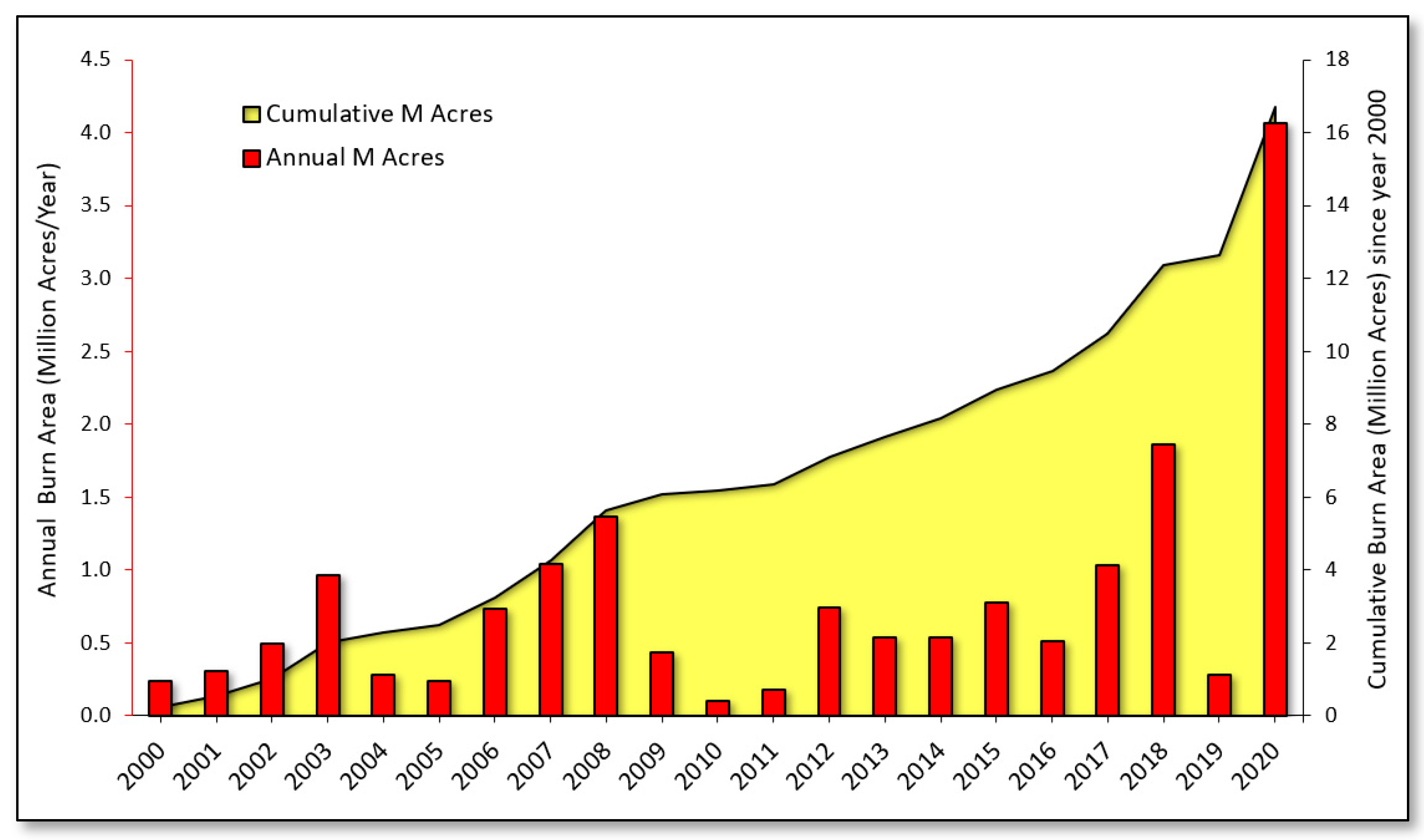
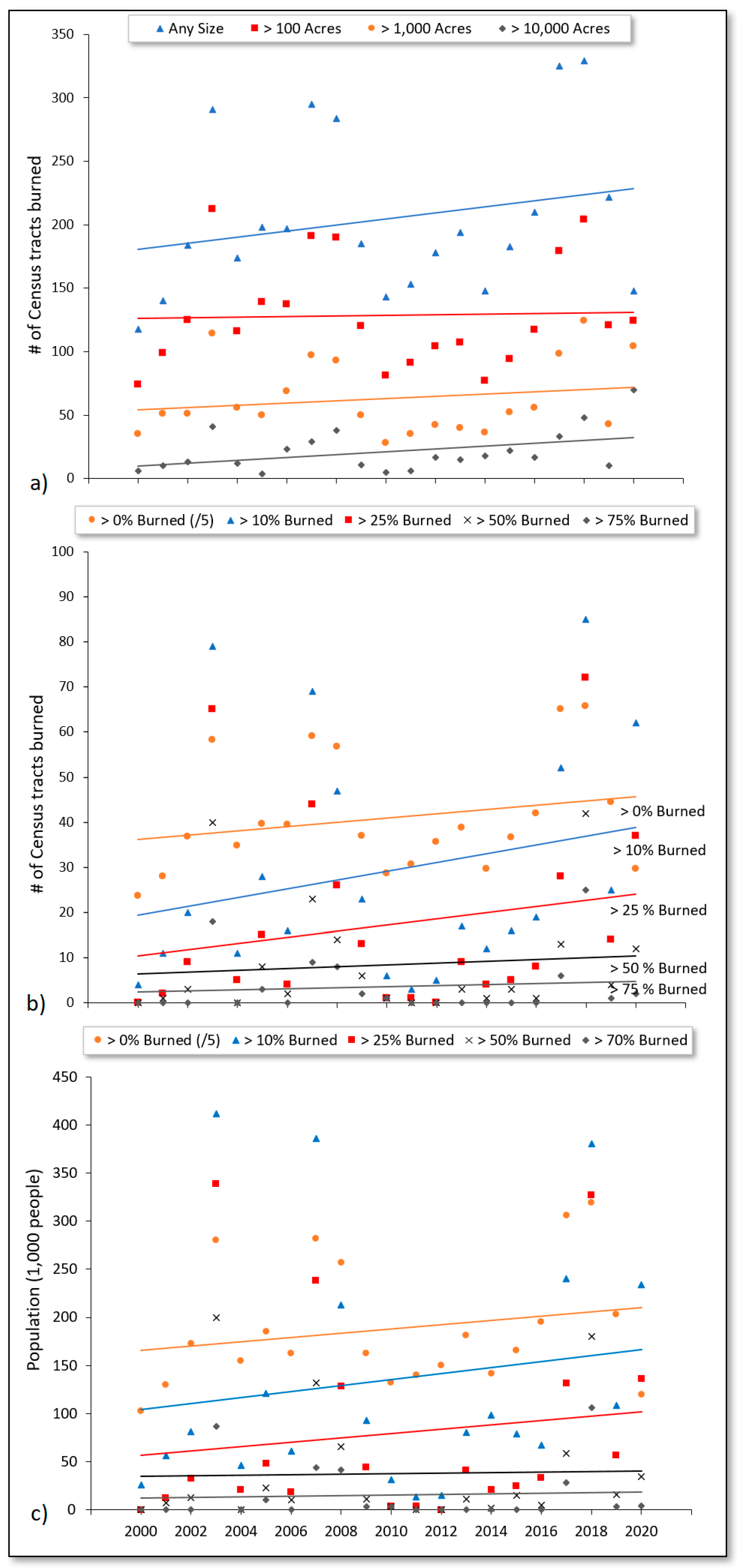
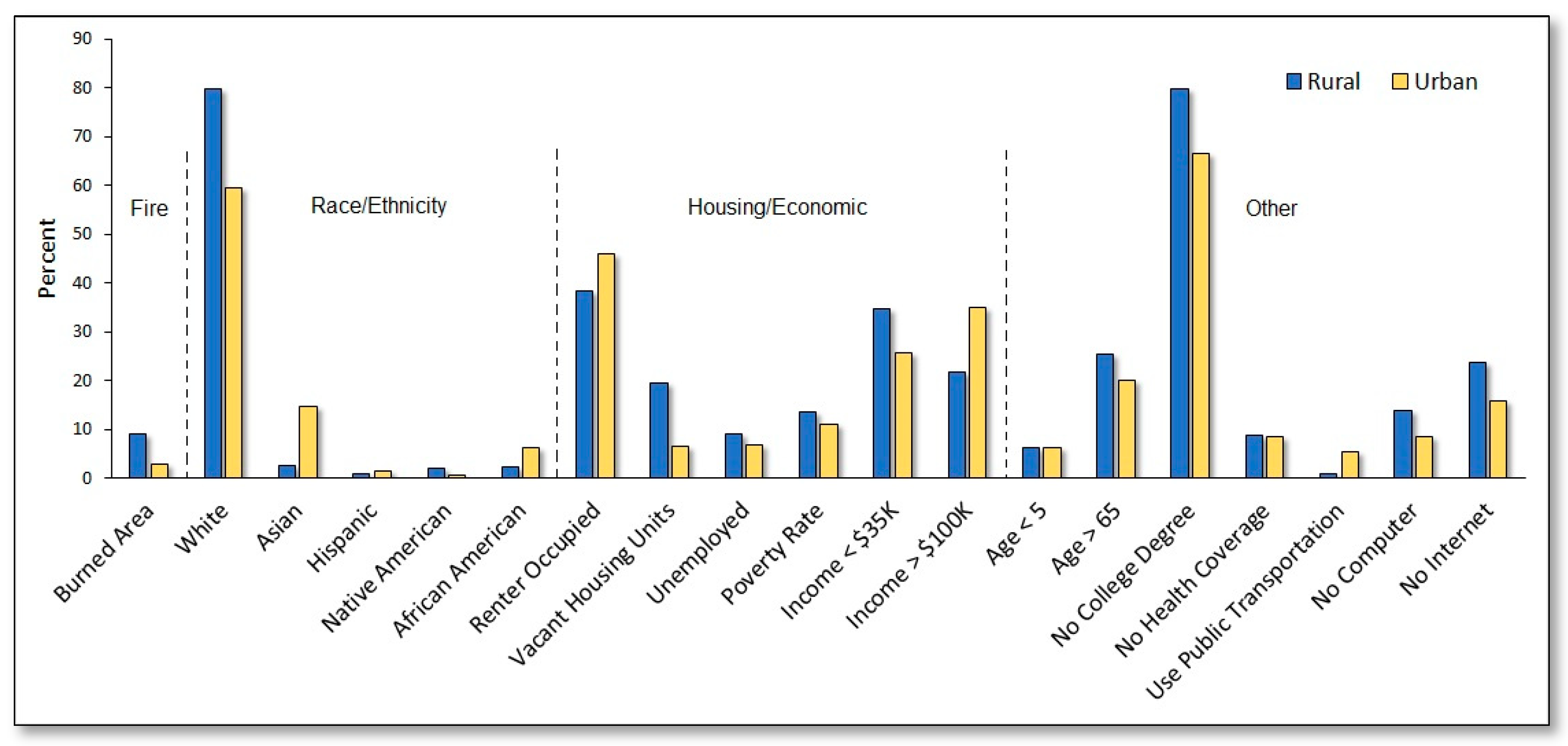
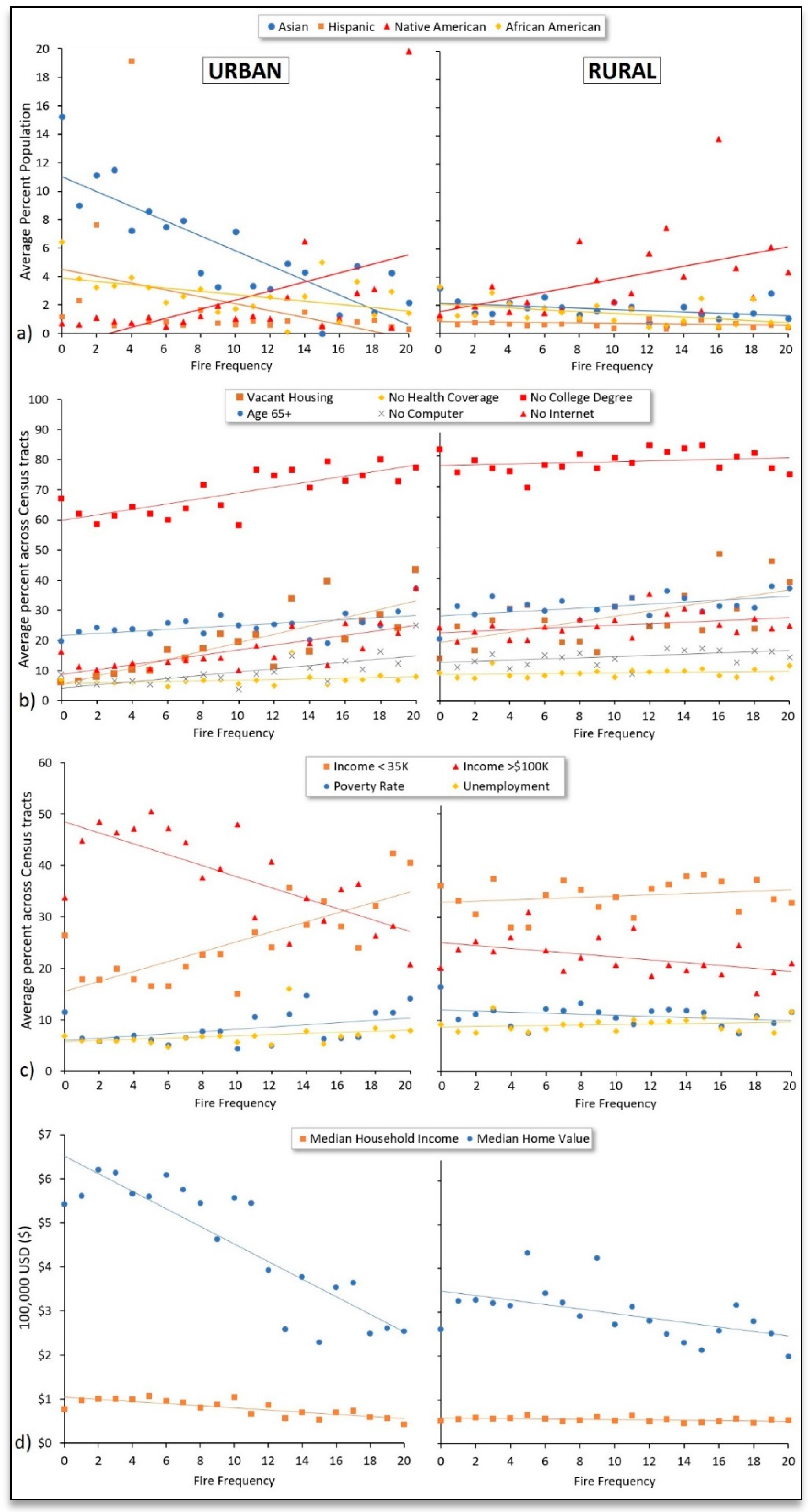

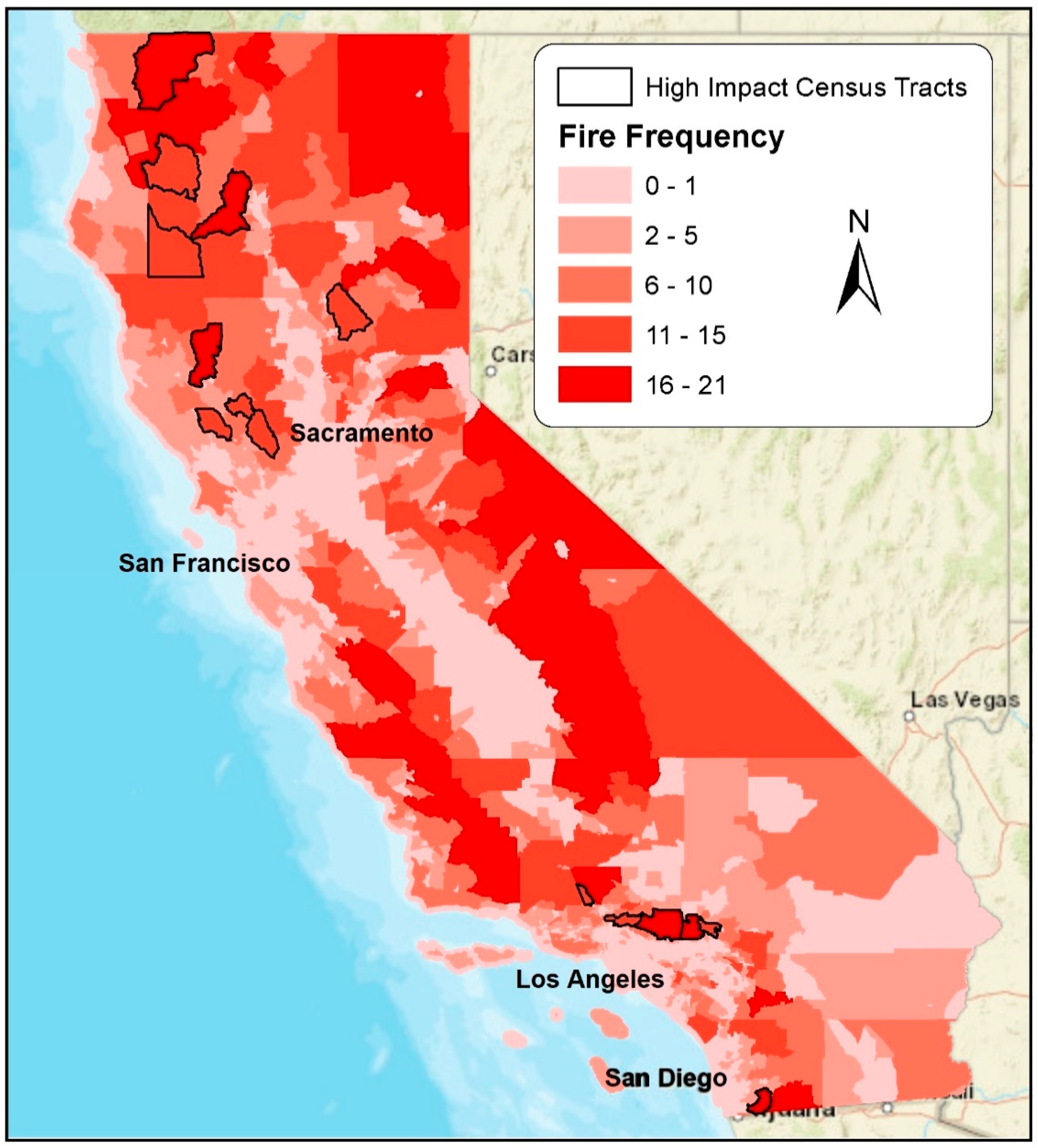
Publisher’s Note: MDPI stays neutral with regard to jurisdictional claims in published maps and institutional affiliations. |
© 2021 by the authors. Licensee MDPI, Basel, Switzerland. This article is an open access article distributed under the terms and conditions of the Creative Commons Attribution (CC BY) license (https://creativecommons.org/licenses/by/4.0/).
Share and Cite
Masri, S.; Scaduto, E.; Jin, Y.; Wu, J. Disproportionate Impacts of Wildfires among Elderly and Low-Income Communities in California from 2000–2020. Int. J. Environ. Res. Public Health 2021, 18, 3921. https://doi.org/10.3390/ijerph18083921
Masri S, Scaduto E, Jin Y, Wu J. Disproportionate Impacts of Wildfires among Elderly and Low-Income Communities in California from 2000–2020. International Journal of Environmental Research and Public Health. 2021; 18(8):3921. https://doi.org/10.3390/ijerph18083921
Chicago/Turabian StyleMasri, Shahir, Erica Scaduto, Yufang Jin, and Jun Wu. 2021. "Disproportionate Impacts of Wildfires among Elderly and Low-Income Communities in California from 2000–2020" International Journal of Environmental Research and Public Health 18, no. 8: 3921. https://doi.org/10.3390/ijerph18083921
APA StyleMasri, S., Scaduto, E., Jin, Y., & Wu, J. (2021). Disproportionate Impacts of Wildfires among Elderly and Low-Income Communities in California from 2000–2020. International Journal of Environmental Research and Public Health, 18(8), 3921. https://doi.org/10.3390/ijerph18083921








